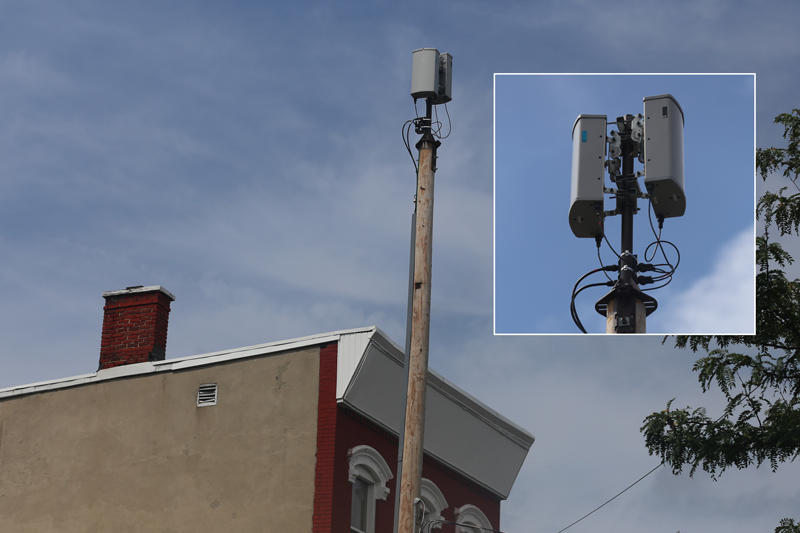Company seeks special permit for small-cell wireless
By Jeff Simms
After months of discussion, and as a neighboring municipality considers settling its own lawsuit with Verizon Wireless, the Beacon City Council is slated to decide on Monday (July 15) whether to allow the telecommunications company to install a 50-foot utility pole on private property on Howland Avenue, a few blocks from Mount Beacon Park.
According to its application, Verizon would mount a 48-inch-high antenna or “small-cell wireless facility” at the top of the pole. The antenna would boost wireless coverage on Beacon’s east side and could be the first of many in the city, company officials say, as Verizon seeks to replace an aging, low-band tower atop Mount Beacon.
That’s one perspective. Another, which several residents and City Council members have suggested, is that approving Verizon’s request could open the floodgates for telecommunications companies eager to build unsightly wireless facilities all over Beacon.

The council recently adopted a small-cell-specific law while also revising an older telecommunications measure. Both provide guidance regarding the location and upkeep of wireless equipment, and on Monday the council can consider only those and a few other factors in deciding whether to issue Verizon a special-use permit for the Howland site.
Under federal law, municipalities cannot cite health concerns when regulating wireless placement. In addition, Beacon’s zoning code only allows the council to deny a special-use permit if the size, nature or intensity of a proposal disrupts the district in which it is located, or if the proposal would not provide adequate parking.
In Putnam County, Homeland Towers and Verizon last year sued Philipstown and Nelsonville after both municipalities denied applications for 100-plus-foot cell towers. In Philipstown, a tower was proposed for a hillside along Vineyard Road, off Route 9. The Nelsonville tower was planned for a property overlooking the Cold Spring Cemetery.
The Philipstown Town Board is considering whether to accept a draft agreement to end the lawsuit against the town.
In Beacon, Verizon applied in November 2018 to build what was first envisioned as a 52-foot utility pole at the Howland Avenue site. (The company has since reduced the proposal by two feet.) On Monday, July 8, company officials offered more details on their present and future plans.
The Howland site, if approved, would be the first of “six to eight” facilities Verizon is planning to replace the Mount Beacon tower, which “outlived its usefulness 10 years ago,” Michael Crosby, a company representative, told the City Council. Calling it “one of the most notorious mountaintop sites in all of upstate New York,” Crosby said that Mount Beacon has been overburdened for years and “causes more harm than good” because it interferes with wireless service as much as it provides it.
The tower will eventually be replaced by a series of higher-frequency small-cell units along with larger, “macro” facilities, Crosby said, noting that city officials are “aware of all but maybe a couple” of those future sites. When asked for specifics, Crosby said he “wouldn’t want to be held to just six or eight” sites in case there are more down the line.
Michael Musso, a city consultant, confirmed that the Howland Avenue facility, if installed, would not provide coverage for all of Beacon, calling it a “small in-fill” site that would broadcast wireless signals “at much lower power” than the one on Mount Beacon.
Verizon previously applied to place two other small-cell wireless facilities on Beacon’s west side. Those applications would have been reviewed by the Planning Board, but they have been paused while the company concentrates on Howland Avenue, which falls under the City Council’s jurisdiction because of the size of the proposal.
In addition to those locations, Verizon submitted a map to city officials showing future development sites that appear to be near Rombout Middle School, South Avenue Park and the intersection of Main Street and North Brett Street.
The Howland small-cell facility would be subject to annual safety certification by the Federal Communications Commission, and Verizon would have to re-apply to the city before it could upgrade its antenna to broadcast at a higher frequency, such as 5G.


Verizon Wireless should put small-cell antennas on existing power poles. One pole in a favored location is just the cheapest way for them to do it. They have plenty of money. We don’t need mini-towers in every sight line in Beacon. I will see this new one from everywhere in my front yard and my front porches. At 50 feet, it will be bigger than you think.